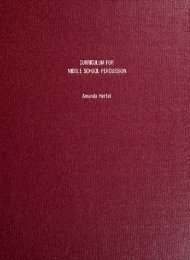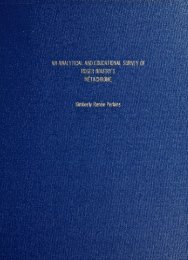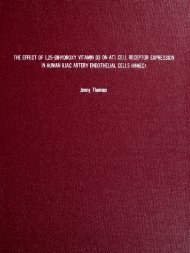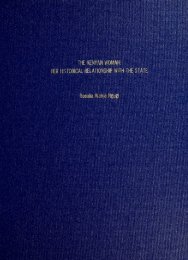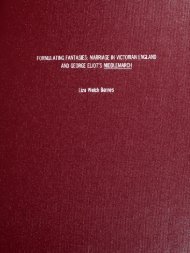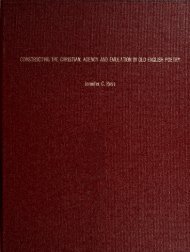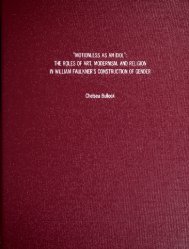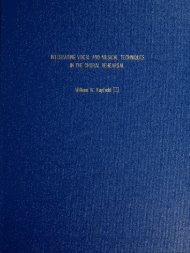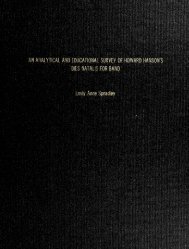ANALYSIS OF SELECTED TROMBONE ENSEMBLE MUSIC BY DR ...
ANALYSIS OF SELECTED TROMBONE ENSEMBLE MUSIC BY DR ...
ANALYSIS OF SELECTED TROMBONE ENSEMBLE MUSIC BY DR ...
- No tags were found...
You also want an ePaper? Increase the reach of your titles
YUMPU automatically turns print PDFs into web optimized ePapers that Google loves.
<strong>ANALYSIS</strong> <strong>OF</strong> <strong>SELECTED</strong> <strong>TROMBONE</strong> <strong>ENSEMBLE</strong> <strong>MUSIC</strong><strong>BY</strong> <strong>DR</strong>. ERIC EWAZENGregory Scott Brandt
Columbus State UniversityAN <strong>ANALYSIS</strong> <strong>OF</strong> <strong>SELECTED</strong> <strong>TROMBONE</strong> <strong>ENSEMBLE</strong> <strong>MUSIC</strong><strong>BY</strong> <strong>DR</strong>. ERIC EWAZENByGregory S. BrandtA Graduate Music ProjectSubmitted in Partial Fulfillment of the Requirements for theDegree of Masters of Music in Music PerformanceSchwob School of MusicColumbus, GADecember 2011
'The undersigned, appointed by the Schwob School of Music atColumbus State University, have examined the Graduate Music Project titledAN <strong>ANALYSIS</strong> <strong>OF</strong> <strong>SELECTED</strong> <strong>TROMBONE</strong> <strong>ENSEMBLE</strong> <strong>MUSIC</strong><strong>BY</strong> <strong>DR</strong>. ERIC EWAZENpresented by Gregory S. Brandta candidate for the degree of Master of Music in Music Performanceand hereby certify that in their opinion it is worthy of acceptance.
illABSTRACTDr. Eric Ewazen is a prolific, and celebrated composer, having written over fifty worksfor brass, thirty-one of which include trombone. His contribution to trombone repertoire issignificant and wide-ranging. Research papers and doctoral dissertations have been writtenabout Dr. Ewazen's instrumental compositions, however none of them have thoroughly exploredhis homogeneous chamber music for trombone or articulated his unique method of composition.Various people with numerous backgrounds listen to, perform, conduct, and teach themusic of Dr. Ewazen. Due to his unique compositional style, it is imperative that one analyzesand reflects on his works to aid understanding. By discussing his compositional methodologyand understanding his compositions within context, my goal is to offer insight to Dr. Ewazen'scompositional style that will allow for an individual to better comprehend his trombonerepertoire. Dr. Ewazen refers to himself as a twentieth century tonal composer and others referto him as a neo-romantic composer. This study seeks to uncover how his use of twentiethcentury atonal techniques, such as set theory, add clarity to interpreting his homogenoustrombone chamber music, and influence his compositional output as a whole.
IVCONTENTSABSTRACT iiiACKNOWLEDGEMENTS vLIST <strong>OF</strong> FIGURES viINTRODUCTION 1BIOGRAPHY 2EWAZEN^ COMPOSITIONAL METHODOLOGY 4EMPIRE FANFARE 5POSAUNENSTADT! 9FANTASY AND DOUBLE FUGUE 14CONDUCTOR'S GUIDE FOR FANTASY AND DOUBLE FUGUE 18CONCLUSION 24APPENDIX A, LIST <strong>OF</strong> COMPOSITIONS INCLUDING <strong>TROMBONE</strong> 27REFRENCE LIST 29
ACKNOWLEDGEMENTAt this time I would like to thank several important individuals for helping me create thisresearch paper. The first people I would like to thank are Dr. Elizabeth Parker and Dr. BradleyPalmer, for all of their professional and personal input into this paper. I am also grateful to Dr.Ewazen for allowing me to conduct a telephone interview to learn invaluable information.Finally, I would like to thank all of the professors here at Columbus State University that I haveinteracted with while creating this paper.
VILIST <strong>OF</strong> FIGURESFigure1. Empire Fanfare, Structure of Sentence 62. Empire Fanfare, Relationship of Tonal Centers 73. Empire Fanfare, Unrelated Triads 84. Posaunenstadt!, Overall Structure 105. Posaunenstadt!, Introduction of Quartal Trichord 116. Posaunenstadt!, Introduction of Vienneses Trichord 117. Posaunenstadt!, Thematic Relationship 118. Posaunenstadt!, Structure of Fugue 129. Posaunenstadt!, Fugue Tonal Centers 1210. Posaunenstadt!, Voice Pairing 1311. Fantasy and Double Fugue, Opening Sets 1512. Fantasy and Double Fugue, Octatonic Scale 1513. Fantasy and Double Fugue, Structure of Sentence 1514. Fantasy and Double Fugue, Fugal Entrances 1715. Conductor's Guideline, Understanding the Set 2016. Conductor's Guideline, Melodic Phrasing 21
INTRODUCTIONToday's music scholars must have an understanding of music literature, especially withintheir primary instrument. Due to the stylistically diverse trombone literature, it is important todistinguish composers who have made considerable contributions. Perhaps the most prolificliving composer of this century for brass is Dr. Eric Ewazen, professor of composition at TheJuilhard School. Ewazen is a celebrated individual having written over fifty works for brass,thirty-one of which include trombone (See Appendix A). His addition to trombone repertoire issignificant and wide-ranging. Research papers and dissertations have been written aboutEwazen's instrumental compositions; however none of them have thoroughly exploredhomogeneous chamber music for trombone.Through interviewing Ewazen and reviewing extant literature, this paper will offerinsight to Ewazen's compositional language in his homogenous trombone chamber music. Dueto the abundance of his works, only single movement compositions will be analyzed, includingFantasy and Double Fugue (1998), Posaunenstadt! (2000), and Empire Fanfare (2002). Thispaper is best suited for either a scholar of music or an individual who wishes to program one ofthese works. The goal of this paper is to propose a conductor's guide derived from theoreticalanalysis.Extant literature has revealed the following about Ewazen's compositional language: (1)his method of composition; (2) exchange of roles; (3) harmonic or rhythmic tension and repose(Chiang 2004, 26; McNally 2008, 26; Smith 2001, 58). While these characteristics arenoticeable in his homogenous trombone chamber music, no apparent studies have beenconducted regarding these works. As a result, this study may offer potential insight to variousindividuals by investigating the following regarding Ewazen's compositional language: (1) How
does the method of composition effect the product? (2) What compositional techniques areemployed that create unity to the work? (3) Chronologically, how does his treatment fortrombone chamber music evolve? (4) How do the above questions help to create anunderstanding and conductor's guide to Fantasy and Double Fugue? The structure of the paperis to first give a brief biography of Ewazen, present an analysis of the selected works, offer aproposed conductor's guide to Fantasy and Double Fugue, and finally discuss Ewazen'scompositional language.BIOGRAPHYEwazen was bom in Cleveland, Ohio on March 1, 1954. He received his B.M. at theEastman School of Music, and his M.M. and D.M.A degrees from The Juilliard School. Histeachers include Milton Babbitt, Samuel Adler, Warren Benson, Joseph Schwanter and GuntherSchuller. He is an active composer as shown through his versatile output. Ewazen favors thebrass and wind instruments and his compositions exhibit a unique style colored with the essenceof Copland, Barber and other iconic American composers (Schulslaper 2009, 10). His workshave been commissioned by numerous individuals both in the United States and abroad, recordedby various school and professional ensembles, and performed by well-known orchestras.Ewazen is one of the most performed, prolific living composers of brass music.While neither of his parents were professional musicians, they both shared a passion formusic. Due to their interests, Ewazen was able to cultivate his own enthusiasm for music. Hismother, Helen, played euphonium in high school and sang in the chorus. After graduating, sheobtained administrative skills through attending a school of business. Due to her fondness of thearts, she took her son to museums, and local school performances. His father, Dimytro, was afactory worker in the steel mills. During the Great Depression, he dropped out of high school to
sell newspapers to help provide for his brothers and sisters. Ewazen's father wanted his son toattend and graduate from college in order to insure a bright future (McNally 2008, 2).At the age of five, Ewazen began to take piano lessons, and soon after he started tocompose his own music. Many different forms of music were appreciated in his childhoodincluding big band, classical recordings, and variety shows such as Dean Martin. This ultimatelylead Ewazen to create his own annual variety show that he directed, played piano, and createdthe script. His first variety show was in fourth grade. At the age often, he started the violin, butthen shortly after switched to cello.In high school, Ewazen continued to cultivate his interest in composition. Ewazencredits his success to Cathy Beech, his high school English teacher, and her husband Joel. Mrs.Beech was a phenomenal horn who attended Oberlin Conservatory. Her husband was aprofessional singer and eventually Ewazen's first theory teacher (McNally 2008, 6). Aftercreating several more compositions, Ewazen submitted them to the Eastman School of Music,which helped him earn his acceptance to the school in 1972.As an undergraduate student, Ewazen deeply immersed himself in the music realm andquickly started learning about the idiosyncrasies of each orchestral and band instrument. Due toEastman's policy, he cycled through different compositional professors (Schulslaper 2009, 10).By learning to compose in a variety of styles, Ewazen started to develop his own language.After earning his Bachelor Degree in Composition in 1976, he attended the Juilliard School ofMusic to earn both his masters and doctorate degrees in composition. Upon graduation in 1985,he was offered a faculty position at Juilliard to teach composition and music literature in the precollegedivision, where he still currently teaches. (Interview with Ewazen, Nov 6, 2011).
^1EWAZEN'S COMPOSITIONAL METHODOLOGYIn order for one to begin to interpret Ewazen's works, it is important to not only havebackground knowledge about Ewazen, but one needs to read about his method of composition.He composes his works at the piano and does not have an overall harmonic structure, instead hebelieves in spontaneity and the magic of composing (Interview with Ewazen, Nov 6, 2011).Improvisation allows him to build upon an idea and work it out (Smith 2001, 27).He employed a compositional "trick" learned from Samuel Adler while writing [TrumpetSonata and Piano] at the piano: Use note-less stems to notate thirty or forty measures toget the general sweep of the passage. This method also allows for the composer toimprovise with rhythmic variation and new colors before committing them to paper. [Ewazen said] 'By the time I write it down (on paper) I am sure of what I want' (McNally2008, 18).Ewazen refers to himself as a twentieth century tonal composer while many refer to himas a neo-romantic composer (Interview with Ewazen, Nov 6, 2011). Due to this combination ofideas, his compositional language is very unique. In general, the twentieth century is known forthe expansion upon atonal composition and the creation of its theory. However the philosophyof atonal composition is considered conflicting with tonal music. By referring to himself as atwentieth century tonal composer, Ewazen paves a new road for his method of composition.Taking different ideas associated with atonahty and applying them in conjunction with tonalcenters creates a very interesting theoretical approach. He said, "Even though my music istonal, my background comes from various kinds of tonality" (Interview with Ewazen, Nov 6,2011).By hypothesizing this relationship, it allows for a more dimensionalized explanation ofhis use of harmonic progression and analyzing his music becomes more comprehensible. EmpireFanfare, Posaunenstadt!, and Fantasy and Double Fugue will be analyzed by: (1) providing abrief overview; (2) exploring the non-traditional harmonic progression in order to comprehend
the logic of the selected tonal centers and thematic material; (3) examining what devices wereused to create textural contrast (rhythm, dynamics, imitation, and so on) and (4) how thisprevious knowledge should be used to one's advantage. With having an understanding of hismethod of composition, here is the analysis of his most recent single movement work, EmpireFanfare.EMPIRE FANFAREEmpire Fanfare was written in 2001 for Joseph Alessi, Virginia Allen, and the JuilliardTrombone Choir. This composition was intended to be a concert opener. This short, quick andlively fanfare is for a trombone octet (six tenors and two basses) and requires a strong principal,as well as a solid bass player due to the range. The entire piece is in common time with no keysignature and all accidentals are included in the parts. There are three main sections to the piece.In the first section (measures 1 to 19) the main tonal centers are C, F, and Bb. Thissection begins with only four parts and then expands into an octet. Throughout the entire work,voices are often grouped together. At the opening, the melody can be found in parts one andthree with a counter melody in parts two and four. Together with the other parts, C major isdefined. The first part outlines the C major scale, with the melody remaining within the diatonictriad. When comparing parts one and two in the first few measures, one can see that thecountermelody is the retrograde of the melody. In set theory a major triad is labeled as 047 (037prime form) and by transposing the set by Tn, it explains the Bb major chord in measure 6.An important way to visually organize music is by looking at the periods of musicderived from the combination of multiple phrases. In Empire Fanfare, when combining phrasestogether to create periods, the periods used appear to be sentences. A sentence is A + A' + B(2+2+4). This is easily noticeable in measure 1 to 8. Instead of relaxing at the end of the phrase,
it builds into the next sentence starting in measure 9. The intensity is due to the crescendo in thetop three voices and the continuous eight notes in the lower parts, as well as the harmonic pushto F major. A period of music generally overlaps with the harmonic progression of the work.For example, when using common practice theory, one could look at a piece of music and see theprogression I-IV-V-I all with a given key. However, due to Ewazen's style of composition, it ishard to put this theory into use. Therefore set theory is being used instead to see the connectivityin his harmonic progression. When analyzing this first sentence we see A as 037, A' as 037 andB as B b CDE b FG or 024579. The set 024579 is comprised of 047 and 259 (See Figure 1). Both ofthose sets in their prime form are 037. Taking all of this into consideration allows one to betterunderstand the coherence with which Ewazen composes. It also places understanding as to thenon-traditional harmonic progression. Knowing this helps one be able to create continuity fortheir group of performers. It is important for the conductor to view music in a connectivemanner, otherwise the music will sound separated to a listener. This is a common problem whenone plays Ewazen's music due to his short rhythmic motives. Therefore by connecting the dots,one can interpret his music in a meaningful manner.Figure 1. Empire Fanfare, Structure of Sentence.£^E^ |=?p piCEG DFA B b CDE b FGThe following can be applied to the rest of the piece to help create a clear viewpoint ofthe entire piece. For example, in measure 44 there is the restatement of the opening, whichallows for the previous analysis ideas to be stated again for this last section. Playing the samemusic twice automatically establishes how the beginning and ending are related. However, that
is only looking at the surface level of the music. In order to get a true grasp one must take noteof the ending tonal center of F major and how it relates to the piece as a whole. The opening andending are harmonically related because all chords fit within the key of F major (F, g, a, B b , C, d)(See Figure 2). Those roots then form the set 024579, which once again is a combination of two037 sets. Continuous use of the set gives coherence and unity to the piece and Ewazen'scompositional language, even while bending the rules of harmonic progression within tonalmusic.Figure 2. Empire Fanfare, Relationship of Tonal Centers.§ g » ft 5=FGAB b CD024579Knowing that the beginning and ending are related via the set 037, leads one to wonder ifthis set is also used the middle section. In the middle section, the piece is in E major, which atfirst glance does not fit in the harmonic progression of either C or F major. A bridge betweenthese tonal centers is needed. In measure 20, C major begins to move to the relative minor inmeasure 22. In the relative minor key, the dominant is E. Then once going through severalharmonic progressions, the key of E major is established. After stating the melody in E major,the piece returns to the original material in C major with an obligate in measure 44. The secondtime, however, the progression from E major to C major does not occur through diatonicrelationships. Instead, by using set theory, the relationship of P4 and P5 is established.In tonal music, these intervals create the circle of fifths. The order of the chords are:EGAEGABGC (all of which are major triads). Major chords do not easily relate to one anotherbased on tonal centers. But when grouped into sets of threes (e.g. EGA, EGA, GBC) and then
^18using prime sets based off of their roots, the following sets appear 025, 025, 015 (See Figure 3).The interval of P4 is recognized. Once each major triad is recognized as the prime set 037, theinterval of P5 is revealed. Finally, when putting them together, the circle of fifth's circle can becreated, hence the repetition of EGA. The common interval of P4/P5 allows for the composer toexplore his use of unrelated triads, without unsettling the listener. Finally coherence is createdbecause all triads are 037, further developing the relationship to the beginning and ending of thispiece also built around the set 037.Figure 3. Empire Fanfare, Unrelated Triads.EGA025GBC015Understanding pitches and their relationship to one another is one way to understand apiece of music. By using this knowledge, one can direct the performers on the harmonicprogression in order for a flow to be established. Without that, the music would soundharmonically separated. Creating continuity harmonically is another analysis that a conductorshould complete. A further analysis one should consider is looking at the texture of the piece; forexamples, rhythm, dynamics, and range.The range of a piece is also an important factor that creates contrast. Empire Fanfare hasa wide range due to the technical skills of the intended performers. The performers' level ofability allowed for Ewazen to push the range of the instrument. A prime example of the drasticuse of the trombone's range can be found in the last several measures of the piece, spanning fiveoctaves from the bottom to the top.
Rhythmic changes also create contrast. When taking a step back and glancing at thescore from afar, one can see that there are more complex rhythms as the piece progresses. Thefirst sentence has several short eighth note runs while the second sentence has several measuressolely comprised of eighth note runs. In addition, the opening melodic and accompaniment partsare phrased horizontally to the listener, but when the melody changes in measure 20, thephrasing becomes vertical. When the melody returns to the original idea, so does its horizontalsound, but the accompaniment remains vertical and very rhythmic. Due to the melody, thej listener primarily recognizes a horizontal sound quality but feels the micro pulse due to theaccompaniment. Because this is only one example of many, it is imperative that the conductorhas a strong understanding of how the parts work individually. However, it is more importantfor the conductor to be able to combine all of the parts together to formulate a musical idea. Theabove analysis synthesized the idea of using set theory to illustrate continuity in this piece andhinted at the use of imitation. The use of these two ideas will be explored in Ewazen's secondsingle movement work for trombone ensemble.POSAUNENSTADT!Posaunenstadt! was written in 2000 for Ithaca College's Trombone Troupe, who was andstill is under the direction of Harold Reynolds. This work has three choirs and each choir is aquartet. This piece is in arch form with several different thematic ideas (See Figure 4). Thesections and the order of the thematic material create a palindrome within the arch form. Thepalindromes assist individual comprehension of the piece. With this step done, one now needs tounderstand the notes of the page and how they are related. Once again by knowing both, onewill be able to better serve their ensemble.
10Figure 4. Posaunenstadt!, Overall Structure.Section A B C B AMeasure # 1 57 121 145 157Order ofThematicMaterialsTheme 1Theme 2Fugue TransitionalMaterialDerived fromPreviousMaterialFugue Theme 2Theme 1The piece begins in B major and ends in D major with two other prominent tonalcenters. Starting with the Section C and working towards the end, tonal relationships are easy todetermine. A major is the relative major key to C major and A is the dominant to D. But howdoes the piece go from B b major in the beginning to C major?Once again turning to set theory provides an answer for a relationship between tonalcenters. One set used in atonal music was the quartal trichord, 027. This set is importantbecause the intervals created are perfect fourths and fifths, which are the building blocks for thecircle of key signatures. It is important to note that in order to break the circle of fifth's, onemust leap a tritone. Another important chord in set theory is the Viennese trichord 016. Theprevious two aspects both contain a tritone, a very important interval to atonal and tonalcomposers, but for different reasons.The opening of the piece is in B b and the main chords used in the first section are B b , E b ,and F, which is shortly followed by a section pitched around E b thus making the three chords E b ,A , and B . In theme 2, three primary chords are E, A, and B. These three sets of chords areessentially the same idea: tonic, subdominant, dominant. When these sets are put in prime formthey become 027, known as the quartal trichord (See Figure 5). Therefore the intervallicrelationship that is associated with 027, directly applies to the relationship between the chords
11that Ewazen is using. Furthermore the relationship between the tonal centers within each tonalcenter creates the Viennese trichord (See Figure 6).Figure 5. Posaunenstadt!, Introduction of Quartal Trichord.B b , E b , F027E b A b B b027E AB027Figure 6. Posaunenstadt!, Introduction of Viennese Trichord.B b E b E016Observing these relationships allows one to understand how Ewazen formed his ideas.One can then make sure that different choirs play in a cohesive manner even though the threechoirs do not appear that way on the page. Using set theory to find coherence in Empire Fanfareand later in Fantasy and Double Fugue worked extremely well. However, in Posaunenstadt!,while one can find occurrences of set theory, it does not provide answers as readily. Forexample, between measures 58 and 62, Choir B and C are playing the same material but indifferent tonal centers. When assigned sets, a potential relationship exists. Also, whencomparing measure 58 to 62 and 59 to 63, they can map onto each other by the transposition ofT5 (See Figure 7).Figure 7. Posaunenstadt!, Thematic Relationship.Measure #PitchesSetMeasure #PitchesSetChoir C58F # G A b A C01236Choir B62C # D E b E G0123659D E b F F # A b0134663A B b C C # E b "01346
12In addition, this part of the piece is written in a fugue manner. Fugues are veryenjoyable, yet difficult to properly piece together. In order for this section to be performedcorrectly, it is imperative that one correctly identifies the following: the subject, the answer, thecounter subject, any episodes, and middle entries that exist. Below is a chart that illustrates thestructure of the fugue starting at measure 57 (See Figure 8). Within this fugue, the Viennesetrichord explains the tonal relationship between the subject, the answer and the middle entry (SeeFigure 9).Figure 8. Posaunenstadt!, Structure of Fugue.Part Subject Answer Subject Answer Episode MiddleEntiyEpisodeMeasure # 57 61 68 72 76 84 92Figure 9. Posaunenstadt!, Fugue Tonal CentersSubjectCAnswerMiddle EntryF#There are not, however, enough examples within this piece to demonstrate set theory as a solemethod of analysis. This appears a bit quizzical because chronologically, Posaunenstadt! waswritten between Empire Fanfare and Fantasy and Double Fugue. Therefore, one should turntowards another important compositional device that Ewazen frequently employs, imitation androle exchange between the parts.Posaunenstadt! is organized into three separate choirs where each one is a quartet. Thequartets are able play different roles. To open this piece, all the choirs play the same ideatogether to create a very strong opening. Then in measure 10 when the opening idea is restated,Choir C becomes the accompaniment choir. That role is then passed to Choir B shortly after.
13The next section starts in measure 27 with Choir A only, who then directly passes the phraseonto Choir B and finally it ends with Choir C. From measure 27 to the new idea in measure 57,it is very easy for one to look at the score and notice how the parts are exchanging roles. Onemelody is passed throughout each choir throughout the entire piece (See Figure 10).Figure 10. Posaunenstadt!, Voice PairingHowever, one choir playing melody with others accompanying is not the only method Ewazenuses to combine the quartets. He also combines the same parts but from different choirs. Forexample in measure 76, part four from each choir is playing the same bass line while parts one,two and three are also playing the melody together. When the original material from thebeginning comes back in, so does the original voicing. Everyone plays the same parts together.Because each choir acts as a solo quartet at times, it is necessary for each to have a strong lead
14player that cannot only lead their individual quartet, but can precisely imitate the other's materialwhen it is their turn.Similar to that of Empire Fanfare, set theory and imitation were two concrete approachesused to break down these works. Separating Ewazen's compositional methodology into its twoaspects, twentieth century and tonal, beings to solidify how to prepare one of his works. All ofthe previous devices will be further explored in his first single movement work for tromboneensemble.FANTASY AND DOUBLE FUGUEFantasy and Double Fugue was commissioned by and dedicated to the JuilliardTrombone Choir and was premiered at the 1998 International Trombone Festival within theUniversity of Colorado-Boulder. This lively single movement work is for trombone octet andhas two main sections as the title indicates, fantasy and fugue. Similar to that of Empire Fanfareand Posaunenstadt!, all of the accidentals are included in the parts.The opening half of the piece, Fantasy, is comprised of two main ideas. One iscomprised of very dense, loud chords, and the other includes a flowing thematic idea. Originallywhen comparing the chords to each other, little relationship can be established. However, onceagain, when using set theory, a relationship becomes apparent. Within these opening chords,there are only two sets used until measure 15, including 0258 and 0137. However, 0258 can berecognized three different ways. The diagram below shows the three different forms of 0258 andthe only version of 0137 (See Figure 11). During these measures, there are a total of thirty-onechords with no apparent pattern appears. However, it is interesting to note that the numberthirty-one itself is a prime number which can explain as to why there is no pattern in the order tothe sets - they are in a prime order themselves.
15Figure 11. Fantasy and Double Fugue, Opening Sets.C # EGA EGB b C B b C # EF # AB b CEIn addition, when putting these notes in order and adding the note E , the octatonic scale iscreated (See Figure 12). This further leads to the idea that Ewazen uses twentieth century atonaltechniques in a tonal manner.Figure 12. Fantasy and Double Fugue, Octatonic Scale.*&-4"XT"-o-The next part of the opening is the flowing thematic idea, which begins in measure 15.This melody can be found in unison between the first two parts from measure 15 to 22. Themelody, similar to that of Empire Fanfare is in the form of a sentence, but this sentence structurehas a slight twist because of the melodic ideas. A prime example of this is in measure 15 and 16that maps directly onto 17 and 18. This same process can be done for measures 19 and 20 ontomeasures 21 and 22, followed by two measures of the opening chords. The diagram belowvisually explains how all of these measures can be put together to create the form of a sentence(see Figure 13).Figure 13. Fantasy and Double Fugue, Structure of Sentence.Sentence from 15 to 2415& 16 19&20 23&24Starting at measure 25 with parts three and four, the same above principal can be appliedhere for A and A'. When grouping the melody in two measure segments, a pitch center can beestablished. For example in 15 and 16, the collection of pitches creates D major and in measure19 and 20, C mixolydian is articulated. D major and C mixolydian share selected pitches, but
16there are also a few that do not relate. By creating a set for each measure individually, only thesets 02357 and 01358 are created. When remembering the originally used sets for chords, 0258and 0137, similarities and differences between the chordal sets verses the melodic sets come tolight. The most important relationship is the first three numbers of the opening sets (025 and013) can be found in the later ones. It is possible that the melodic sets were created off of theopening chordal sets.The word fantasy is defined as the act or function of forming images or representationwhether in direct perception or in memory (Gove 1993, 823). By applying that definition onecan state that all of these short, yet different ideas, are representations of one another.Throughout the entire first half of this composition, the sets 0258 and 0137 are dominant. Forexample, these two sets are also found in the melody and accompaniment in measure 33, 43, andthe melody in measure 51. Then for the first time in measure 69, a new idea of how these twomight interact is demonstrated, which is only adds to how Ewazen uses these two sets. Thisthrough-composed section reflects Ewazen's method to write down an idea and then improviseupon it. For the first time in this piece, measure 69 to beat two of measure 76, everyone isplaying within one tonal center, D b Major. But in order to end this episode, beat three ofmeasure 76 goes back to the originally chordal set (0258), finally bringing this representation toan end. The first half of this piece finishes with a brief review the first melody and a transition tothe double fugue.The fugue's tonal center is G Lydian and first appears in parts three and four, which isfollowed by a tonal response from parts five and six in measure 99. Then parts seven and eightenter with the same material at 106 and finally parts one and two play the material at measure110. Although a traditional fugue has subject and countersubject, because this is a double fugue,
17both subjects are presented simultaneously and have equal importance. When comparing thefirst note of the lower parts of all of these statements (part four, part six) they are G, D, G, D.This establishes the relationship between G Lydian and D Ionian (See Figure 14). The idea offourths once again establishes quartal harmony, similar to that found in Posaunenstadt!.Figure 14. Fantasy and Double Fugue, Fugal Entrances.Beginning in measure 118, the material returns to the original voices, however the parts haveswitched roles and the top part begins on D. This helps to reinforce the end of the episodes andthe start of the development of the fugue in measure 124. The material returns to the originalvoicing, but the material is segmented between different pairing of voices, which furthers thedevelopment of a new tonal center (G b Lydian). Similar to the pairing between entrances, arelationship between G b Lydian and D b Ionian are established. D b Ionian was previously used inmeasure 69. The material used in mesure 69 is stated again in measure 143 but this time in thekey of E major. Perhaps, due to the title of this piece Fantasy and Double Fugue, Ewazen did
18not want the listener to forget what had previously happened. In addition, this is the second timewhen every part is playing in rhythmic unison which helps establish coherence.A common technique used in the development of a fugue is diminution andaugmentation. Augmentation can be found in parts three and four, where the original subjectsreturn in their original key to the original parts. Similar to how the material in measure 69 wasrestated, the material from measure 15 also makes a return, which finishes with the chordal setsfrom the very beginning of the composition. From measure 159 to the end, Ewazen returns tothe first flowing melody of the piece.Throughout this composition, Ewazen pairs voices together, which allows for imitationand development of the material. It also allows the accompaniment to be comprised of strongrhythmic motives. Having strong and short rhythmic pulses can easily interfere with thethematic material. Therefore it is the conductor's job to make sure that the accompaniment doesnot become vertical, but instead has a forward feeling to match the melody. Dynamics in thispiece are used, but not often. The most important marking is fortissimo, which is only usedwhen the original chordal sets are played. Therefore, the conductor must make sure thatfundamental chords are always played with great intensity each time. In addition, while there aretwo measure phrases, these phrases must be combined together into periods in order to avoidchoppy and segmented sounds. While there are not many articulation markings, they should beconsidered strongly, such as accents and slurs.CONDUCTOR'S GUIDE TO FANTASY AND DOUBLE FUGUEA conductor must be immersed in studying the works to be performed. Score studyincludes time with the work itself, learning about the composer, after which the conductordecides to highlight what s/he considers the most important material within the music. When
19one selects the music of Ewazen, they should expect significant emotional expressiveness in thescore, hence his designation as neo-romantic.During score study, the conductor should examine the piece on both a small and largescale. This will allow for that individual to not only learn the basics of each part, melody andharmony, but the overall structure of the piece as well. By knowing both, the conductor canbring out certain points that would have otherwise been overlooked. The previous analysesexplored the use of set theory, harmonic relationship and how the parts were intertwined mainlyon a small scale. Below is an example of how to take this previous knowledge in conjunctionwith a larger look in order to create a more thorough understanding to Fantasy and DoubleFugue.In this piece, the chordal sets for the beginning (0258 and 0137), expansion andrestatement of these two sets within the double fugue, and finally pairing of parts, appear to bethe important elements. Because the chordal sets are used numerously throughout the piece, aconductor must make sure that when they are used in their original form they are performedsimilarly. The only sections marked fortissimo are the original opening material and itsrestatements. In this piece, one should consider dynamics as levels of intensity; hence thedynamic marking of piano can be played delicately and forte boldly. By using adjectives, theconductor can relay a sound concept that reflects upon a feeling, which is important because ofEwazen's neo-romantic classification. After all, the goal of a conductor is to understand thecomposer's intentions and relay those feelings to the audience via the performers.In addition, there are limited articulation markings throughout the work, which createsplenty of room for interpretation. For example, the opening chordal sets are eighth notes with afortissimo marking. In general, players without guidance will play these chords with a very
20aggressive articulation. This will automatically give volume and definition to the notes, but theclarity of the chord will suffer. Here, the conductor needs to instruct how the chords will bestated and this discussion should be done based on analysis. Since these opening chords areimportant for several reasons, they need to be strong, bold and have clarity. In order for this tohappen, one could interpret the articulation as such. One suggestion is to have the players use a"tAW" syllable. Having the small "t" will give clarity to the front of the note and "AW" willmean the note will be full and supported. The correct ratio of tongue to air is important toproduce a good sound that an audience member can comprehend. An excellent description ofthis relationship can be found in David Vining's book Daily Routines (2002, 15-6).Intonation is another important concept that a conductor needs to address with the group.However, how does one tell their performers to tune the set 0258? An A 7 chord is revealed whenthe set is rotated and tuning the chord would be as follows: center the root, lower the major third,raise the fifth and lower the seventh. By following that process, one can tune the other chords ina similar manner. However, how should one tune the chord presented in measure 7 including thepitches B b , D b , E, F # ? Enharmonically, the chord is spelled G b , B b , D b , F b or G b7 . Therefore onecan follow the same adjustments previously used. Even though the chord is not written that way,the analysis reveals the chord was 0258, just like the A 7 chord. For this piece, the set 0258 is andwill always be some kind of seventh chord (See Figure 15).Figure 15. Conductor's Guide, Understanding the Set.C # EGA0258AC # EG8025However, how is one to address the other set used in the opening, 0137? Once again by rotatingthe set, a ninth chord is created. Therefore the conductor can tune all of the opening sets similarto that of a major or minor triad plus extensions.
21Melodic Material In Fantasy And Double FugueNow that we have uncovered some of the foundational material from this piece, it is time tomove onto the different melodies that are derived from the sets. At measure 15, the conductor ischallenged to take musical material and turn it into a musical phrase that can be expressed to theaudience. When remembering how the sentence was created, the conductor must make sure thatthe players identify the three parts A, A' and B and how they are related together. It is easy for aplayer to view the melody as several two bar phrases, which is technically correct. But inpractice, it must sound like a ten-measure phrase. Playing a ten-measure phrase is moredemanding and difficult than a playing a two-measure phrase. Therefore it is suggested that theconductor might instruct the players do the following for phrasing (See Figure 16).Figure 16. Conductor's Guide, Melodic Phrasing.§ ^-^ st^n^-Ef^^-Ck% r i^i2i"ri;'gggimm £^T' ririN^/^A-^^q^q^feiThe melody is in a range that is not easily projected. When played at the same dynamiclevel, a whole note will sound louder than a quarter or eighth note. Therefore the six other partswill need to play softer. The melody can be played more intensely as indicated by the dynamicmarkings. Then with the repeat of the melody in parts three and four in measure 25, the sameidea should be repeated. An added challenge becomes apparent, because parts one and two areplaying in the upper part of the range which projects very easily. They are also marked adynamic level louder. This creates the question, which is more important, the restatement of themelody or the new material in the upper two parts? One could argue either way, but clearly one
22of the ideas needs to be the lead while the other is the support. The dynamics suggest the upperparts should be leading the ensemble.The phrases for the ten-measure segment beginning at measure 33 are uneven. Instead ofhaving a regular two or four measure phrase, this period uses three measure phrases, which is 3 +3+4. Even though there are an odd number of measures in the phrase, they still need to push tothe last two measures where the chordal sets come back in once again. One way to achieve thisis by having the first three measures grow slightly then decay and then go back to the originalintensity. In measure 36, part four should repeat this idea, which will add interest while part fivejoins in with a supportive countermelody. With the addition of this new voice, it creates enoughof a change to the listener. Then on the third time, the melody is played in a new tonal center,thus allowing once again for the listener to not become tired of hearing the same idea. Due tothese changes within the composition, the conductor could interpret that as enough change forthe audience. Therefore, the conductor needs to make sure that with the addition of each newvoice, all of the parts are agreeing on articulation and phrasing. The conductor needs be awareof this, otherwise the audience will not hear what is expected. In addition, the conductor needsto be aware of how Ewazen adds or trades how the parts work together throughout hiscomposition.Next comes a development that has a dreamlike quality to it. Within the section, oneshould attempt to go for this mood until measure 63, where previous material is restated leadinginto measure 69. During this section, the conductor needs to make sure that the musical line isnot being lost due to the passing of the melody from one part to another. Furthermore, oneshould consider conducting this part in a slow two to help give a more open, wandering feeling.However once measure 69 is reached, an immediate change of mood must be created. For the
23first time since the opening, everyone is playing together again and it is within a clearly definedtonal center of D Major. Once again, two measure phrases are evident throughout this sectionand there are literal repetitions of the same material. No material is added or taken away, thusrequiring the conductor to decide how to phrase this period of music. Regardless of whatdecisions are made, the most important chord is beat three of measure 76. This chord is the set0258, which leads the piece back into material from measure 15. From measure 77 to theintroduction of the fugue, the material is mainly a repetition of what has been previously stated.Playing and listening to a fugue is enjoyable, yet preparing one can be tricky. In orderfor an audience member to follow it and not be overwhelmed, the performers must play withinthe construction of the fugue. With this knowledge, one can bring out important structural partsthat add clarity to the fugue. This piece is clearly a double fugue. From the beginning inmeasure 95, parts three and four have the important role of being the first to state the subjects.The manner in which articulation, phrasing, and dynamics are used must be the same from everyplayer. In addition, whenever a part is accompanying, it must be clear, following the phrase ofthe subjects. Accompanying lines must also move with the same intensity that the subject doesbecause every part needs to be musical. While the subject is fragmented, it cannot come acrossthat way to the listener. In measure 151, when the melody line is augmented, the conductorneeds to make sure that the melody line has intensity throughout it. This can be achieved bypacing the intensity in conjunction with the phrase.Indeed the melody needs to be the most prominent voice. However, the accompanimentshould not worry too much about playing "soft." If players worry about playing so soft, thoseparts will then lose clarity. Instead, the conductor should instruct students to play comfortably
24and think about clarity and moving with the melody. Finally with the restatement of previousmaterial, the conductor must manage the energy until the final cadence.CONCLUSIONThe purpose of this paper is to illustrate characteristics of Dr. Eric Ewazen's. Aftercollecting the previously stated ideas from the analyses of Empire Fanfare, Posaunenstadt! andFantasy and Double Fugue, several important compositional aspects pertaining to Ewazen canbe realized which may help individuals gain greater understanding of his compositions.Ewazen works from the piano and writes down general ideas. Once this overall flow iscreated, he goes back and improvises on these ideas, which allows for one idea to be twisted andturned in multiple directions and different key centers. It is easy to see his use of the pianobecause the melodies, countermelodies, and voicing as well as placement of chords easily fitwithin one's hand movement on the piano.Ewazen does not employ a key signature. One reason is to allow himself the freedom tomove from one tonal center to another (Interview with Ewazen, Nov 6, 2011). Furthermore,Ewazen believes that key signatures are too confining and may create an automatic influenceupon a composer (Smith 2001, 24). A third possibility for omitting key signatures may be due tohis experience in atonal music or his own keyboard skills. His atonal experience can alsoexplain his formation of his thematic material and how the phrases relate to one another and arederived from permutations. The use of set theory offers a way of visually interpreting thecoherence between his tonal centers and his development of thematic material.Ewazen uses both close and distant harmony. This harmony is found in all three of theabove works. From Posaunenstadt!, the harmony was recognized by the use of the quartaltrichord and the Viennese trichord. It is recognized in Empire Fanfare from the intervals of sets
25used 037 and finally in Fantasy and Double Fugue, it is in the chordal sets 0258 and 0137. Inaddition, McNally (2008, 19) located the use of quartal harmony in Sonata for Trumpet andPiano, in connection with quartal harmony in use his of modes. Other writers have noted thisand specifically his use of the Lydian mode for the melody with an accompaniment from themajor mode (Smith 2001, 19). This is noticeable in Fantasy and Double Fugue where the GLydian and D Ionian overlap with each other in the fugue. By using modes in this manner,Ewazen creates temporary tonal centers. He states that he enjoys the Lydian mode due to theraised fourth, which gives a very cheerful, uplifting quality of sound (Interview with Ewazen,Nov 6, 2011).Ewazen exchanges the roles between the parts of the ensemble. In general, he will statethe melody in one voice with the accompaniment in another, and then these two parts willexchange roles. This is very evident in his larger setting works because of the number of voiceshe has at his disposal. The best work to locate this idea in is Posaunenstadt!, within the threequartets, which not only shows imitation between parts within one choir but from one choir tothe next.Finally, Ewazen has classified himself as a twentieth century tonal composer. Twelvetone,rotational arrays, serialism, and set theory are several devices associated with twentiethcentury atonal compositions, however these devices can also be used for tonal music as modeledin this research paper. One important twentieth century composer is Anton Webem (1883-1945). Webem used the set 014 extensively, in creating the set 0123456. Within that larger set,there are three 014's. This then allowed for him to expand his choices of notes while stayingwithin the set 014. Ewazen follows the exact same principal found in Empire Fanfare. The firstsentence from Empire Fanfare can be seen A as 037, A' as 037 and B as 024579. The set
26024579 is comprised of two 037 sets. Thus, Ewazen follows a similar pattern that Webem usedwith combining 014s together to create larger sets. In Fantasy and Double Fugue, the opening iscomprised of various chords that seem to have little relationship to each other, but they do. Eachchord is either 0258 or 0137. These two sets are then used throughout the entire composition andcan be found either in combination or with each other creating a larger set. Once again, Ewazenuses sets in much the same way as Webem. Both use one set and then expand upon it to createmore colorful options.Synthesizing these four ideas along with Ewazen's method of composition helps toclarify how to interpret his unique compositional language. By understanding his language, onecan determine how to conduct, play or evaluate a performance of his works. Ewazen's trombonerepertoire is extensive with many pieces being performed internationally and several becomingstandards in the repertoire. Finally and most importantly, Dr. Eric Ewazen is a composer whodeserves recognition for his contributions to the twenty-first century.
27APPENDIX AList of Compositions by Eric Ewazen Including TromboneAlto Trombone1. Palmetto Suite for Alto Trombone and Piano, (2004)2. Palmetto Suite for Alto Trombone and Orchestra, (2010)Tenor Trombone1. Sonata for Trombone and Piano, (1993)2. Visions of Light, (2003)3. Songs of Love and Loss, (2004)o For tenor or bass trombone4. Rhapsody for Trombone and Pianoo Original version for bass trombone and string orchestraBass Trombone1. Concerto for Tuba or Bass Trombone and Piano, (1995)2. Concertino for Bass Trombone and Trombone Choir, (1996)3. Ballade for Bass Trombone and Piano, (1996)o Original version for clarinet and string orchestra4. Rhapsody for Bass Trombone and Piano, (1997)o Original version for bass trombone and string orchestra5. Songs for Love and Loss, (2004)o For tenor or bass tromboneTrombone Ensemble1. Dagon II: Nine tracks of Bass Trombone, (1980)o Can be performed with tenor and bass trombones2. Concertino for Bass Trombone and Trombone Choir, (1996)3. Grand Canyon Octet ,(1996 hom version)4. Fantasia and Double Fugue for Trombone Choir, (1997)5. Capriccio for Bass Trombone and Trombone Choir, (1999)6. Myths and Legends: Trombone Quartet, (2000)7. Posaunenstadt: Trombone Choir, (2000)8. Great Lakes Fanfare: Trombone Choir, (2002)
28Brass Ensemble1. Symphony in Brass: Brass Ensemble w/ Percussion, (1991)2. A Western Fanfare: Brass Ensemble w/ Percussion, (1997)3. Grand Canyon Sinfonia: Brass Ensemble, (2000)o Original version for hom ensemble4. Front Range Fanfare: Brass Ensemble w/ Percussion, (2003)1. Colchester Fantasy, (1987)2. Frost Fire, (1990)3. A Western Fanfare, (1997)4. Grand Valley Fanfare, (2001)Brass QuintetMixed Brass1. Pastorale: for Trumpet, Trombone and Piano, (1996)o Original version was the middle movement of Ballade, Pastorale and Dance for flute,hom, and tenor or bass piano2. A Philharmonic Fanfare: for Trumpet, Horn, and Trombone, (1997)3. An Elizabethan Songbook: for Trumpet, Trombone and Piano, (1998)o Original for mezzo-soprano, tenor, and pianoTotal Works for or Including Trombone: 31
29Reference ListChiang, Fuchou. "Eric Ewazen's Concerto for Bass Trombone and Orchestra: An Analysis andPerformance Guide." M.M diss., California State University, 2004. In ProQuestDissertations and Theses,http://search.proquest.com/pqdtft/docview/305036979/132E118C39C5E13696B/naccountid=T0196 (accessed September 2, 2011).Ewazen, Eric. 2002. Empire Fanfare. International Trombone Association Manuscript Press.Austin, Texas.- 2000. Fantasy and Double Fugue. International Trombone Association ManuscriptPress and Southern Music Company. San Antonio, Texas.. 2000. Posaunenstadt} International Trombone Association Manuscript Press andSouthern Music Company. San Antonio, Texas.Gove, Philip Babcock, and The Merriam-Webster Editorial Staff. 2000. Webster's Third NewInternational Dictionary of the English Language Unabridged. Springfield: Merriam-Webster Inc., 2000.McNally, Joseph Daniel. "A Performer's Analysis of Eric Ewazen's Sonata for Trumpet andPiano. DMA diss., The University of Southern Mississippi, 2008. In ProQuestDissertations and Theses,http://search.proquest.com/pqdtft/docview/304465269/132E11964DE525F9F2B/17accountid=10196 (accessed September 2, 2011).Schulslaper, Robert. "Brass and Beyond: The Music of Eric Ewazen." Fanfare Magazine no. 6,(July/August 2009). http://www.fanfarearchive.com/indices/itop/issues/hl_1511.html(accessed October 7,2011).Smith, Thomas Rodgers. "The Use of Trumpet in Selected Chamber Works of Eric Ewazen."DMA diss., The University of Texas at Austin, 2001. In ProQuest Dissertations andTheses,http://search.proquest.com/pqdtft/docview/304718380/132E119E8712 AC5FB6C/1 ?accountid=10196 (accessed September 2, 2011).Vining, David. 2002. Daily Routines for trombone. Denton, TX: Kagarice Brass Editions.



